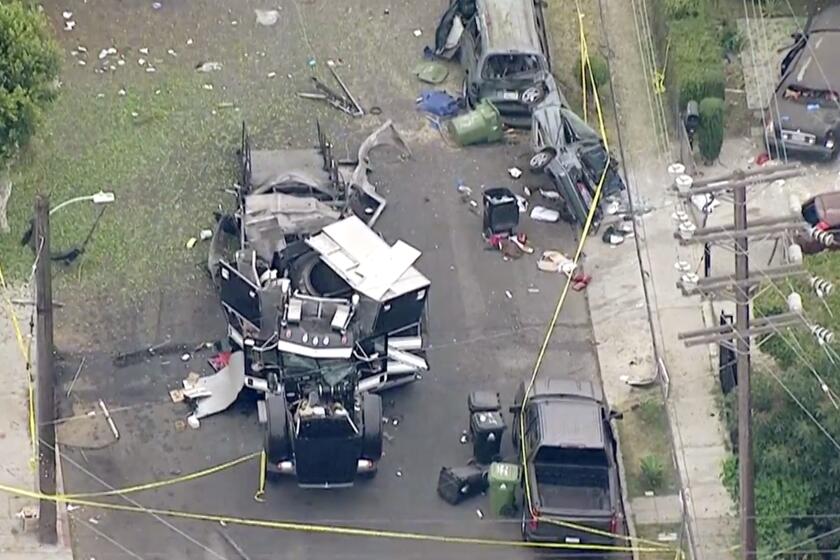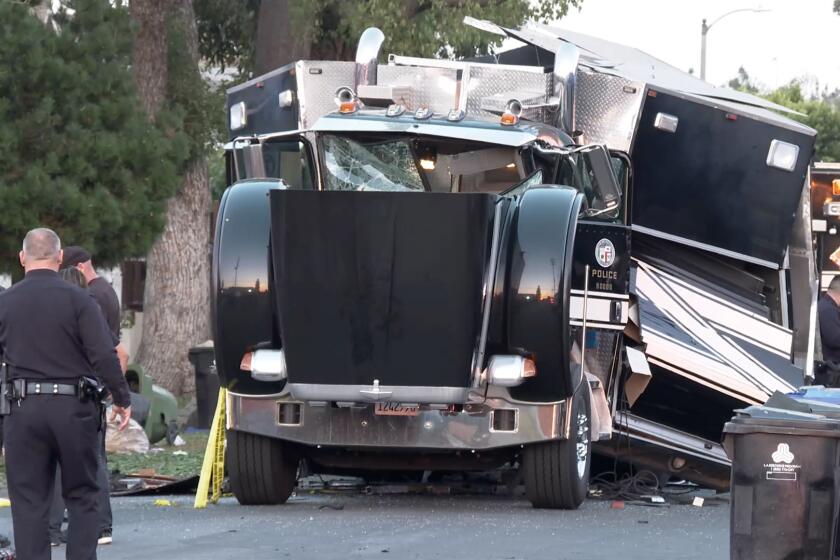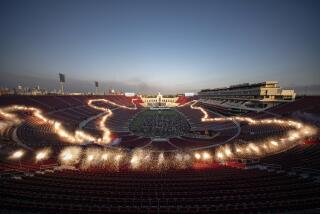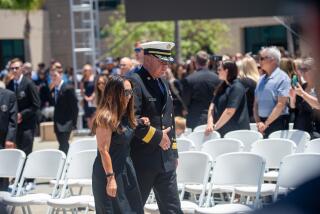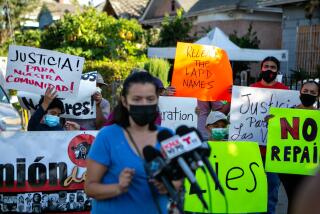How did the LAPD manage to blow up a South L.A. block while seizing fireworks?
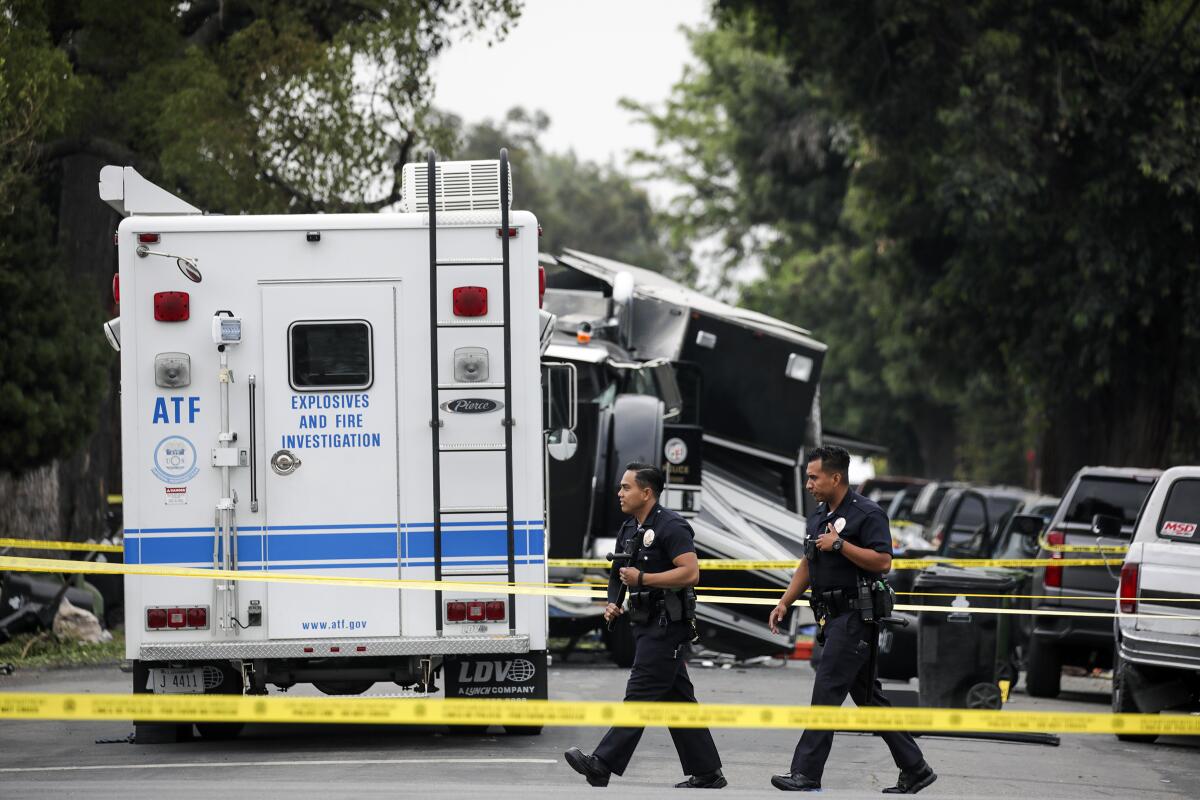
When Los Angeles police discovered a few thousand pounds of illegal fireworks in a South L.A. yard Wednesday morning, some of the explosives were particularly troubling to members of the bomb squad.
The department’s explosives experts were content to haul off nearly all of the illegal stash to a secured location for destruction. It was a run-of-the-mill operation in the lead-up to the Fourth of July in a city obsessed with fireworks.
But about 40 soda can-sized items and 200 smaller items, each with a short fuse and unknown firepower, gave them pause. They were uncertain the devices were stable enough to transport.
Instead, they tried to safely detonate the devices in a specialized container right there on the street — and caused a massive explosion that left the residential block in tatters and 17 people injured. It was a disaster captured by television choppers and crews on the ground who’d gathered in the neighborhood to record the fireworks seizure and detonation.
By Thursday, a massive investigation was underway into how what was meant to be a carefully controlled explosion went so badly out of control — casting debris for blocks, blasting out windows, smashing nearby parked cars, damaging homes and sending elderly residents and officers to the hospital.
The LAPD was also coming under growing scrutiny in the neighborhood and beyond, especially over whether there was more the department could have done to protect residents and get the explosives out of the densely populated area before they were detonated.
Residents of the South L.A. neighborhood where the LAPD seized fireworks and improvised explosives, triggering a blast with a detonation gone wrong, demand answers and accountability.
“Why didn’t they do this somewhere else?” asked Louis Price, a local resident who said he didn’t know why police hadn’t warned residents on his block to leave. After all, they had essentially “made a bomb themselves” by choosing to detonate the explosives in his neighborhood, he said — sending out a burst of wind that shattered windows.
While local U.S. Bureau of Alcohol, Tobacco, Firearms and Explosives agents were at the scene at the time of the blast — one was injured — the ATF’s national response team was en route to South L.A. on Thursday, officials said. Agents and other public safety personnel scoured the neighborhood for any explosives that may have been left undetonated.
ATF investigators will also delve into a slew of questions about how a man arrested for possessing the fireworks obtained such a large, volatile stash, and whether human error, an equipment failure or some combination of the two led to the explosion.
Michael Knight, an ATF spokesman, said the probe will be broad and include an examination of the explosives themselves, including “what type of product was in there, the weight of the product, and the explosive yield of the product.”
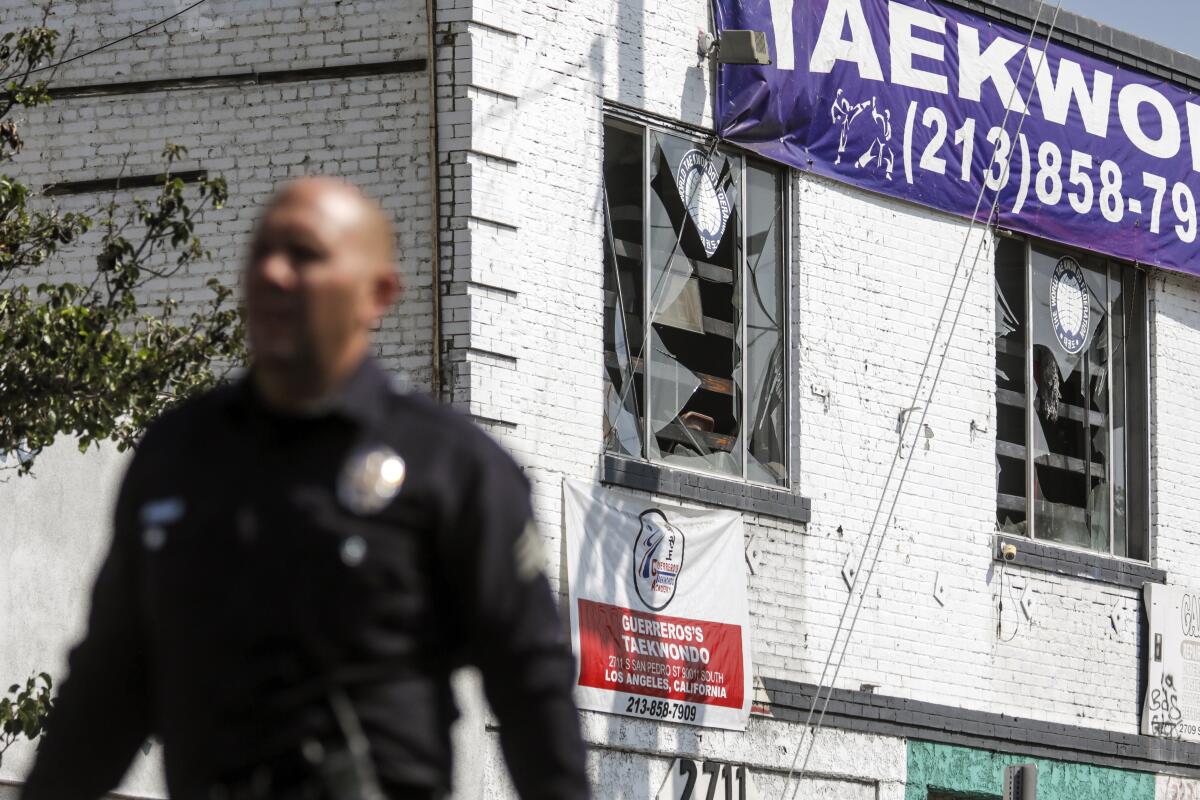
The agency will also consider “the integrity of the equipment used” by the LAPD. Specifically it will look at the massive black containment vehicle that was driven onto the block and inside of which members of the bomb squad attempted to safely detonate the explosives. They will try to answer whether the vehicle was somehow compromised or police miscalculated its ability to withstand the blast.
In search of answers, the ATF will conduct “forensic mapping” of the entire site and the spray of debris, Knight said.
“They’ll put that into a computer-generated rendering, and that will show which direction the majority of the product or container went, the trajectory, the distance,” he said.
The federal agency will also retrace the events leading up to the explosion, not only to track down the origins of the explosives but also to learn what happened from the perspective of bomb squad members and other witnesses, Knight said.
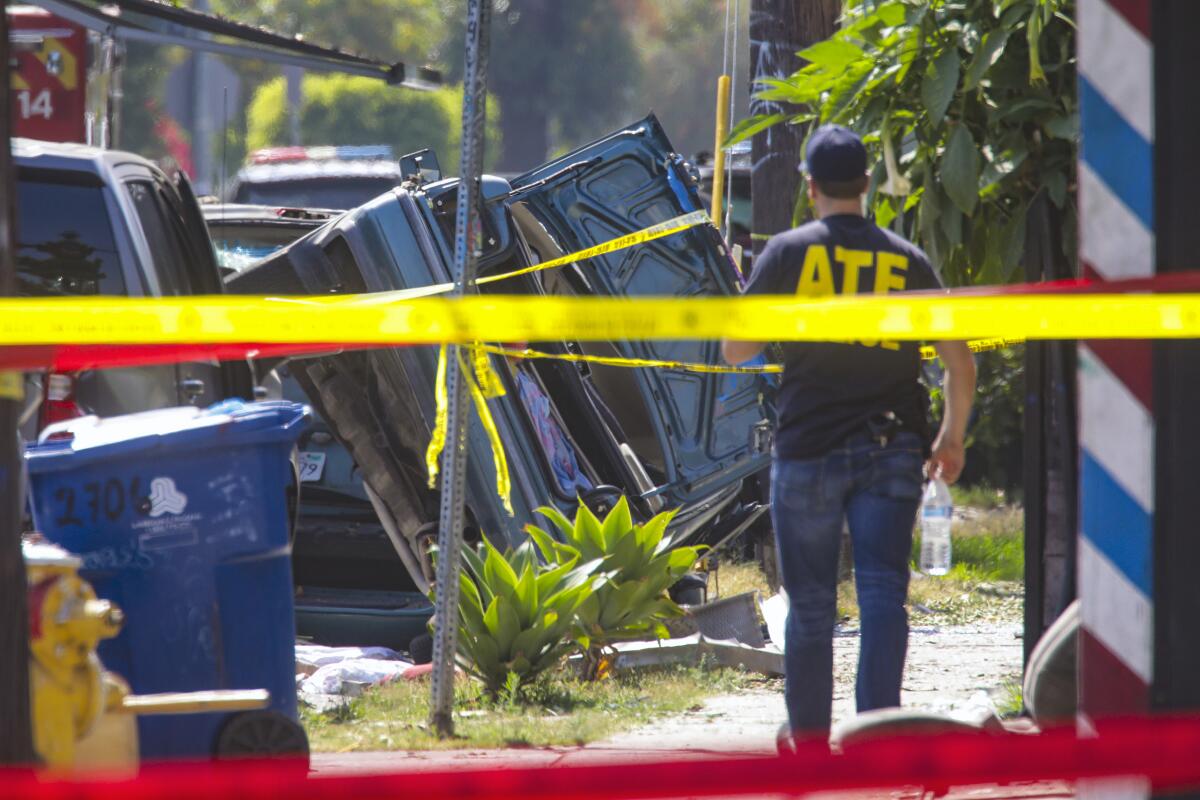
At the heart of the inquiry will be questions about the fateful decision to detonate the homemade devices in the middle of a quiet street lined with homes.
So far, it’s a question the LAPD has only partially answered.
According to Moore, the bomb squad appeared to have “followed established protocols” to assess the unknown devices.
They used X-ray technology to look for any fragment materials, which weren’t seen, and used a robot to cut into one of the devices and draw out a sample, Moore said.
“They cut robotically to determine the content, and it was believed to be explosive in nature,” Moore said Wednesday night. “I’m not a bomb tech so I can’t get more technical than that, but they believe they knew what they had.”
Moore said police knocked on doors to tell residents to evacuate as a precaution. Officers then placed in the containment truck an amount of explosives that they believed it could handle.
“Fire in the hole!” officers yelled.
Moore said it remained unclear why the result was an explosion that wreaked havoc.
In response to a list of questions Thursday, including about the contents of the devices as determined by the initial LAPD assessment, Capt. Stacy Spell, an LAPD spokesman, said the department is fully cooperating with the ATF and “will rely on their assessment of this incident.”
“Out of respect for the investigative process and our investigating partners, we cannot provide the specifics of the investigation at this time,” Spell said.
Authorities were in the process of seizing more than 5,000 pounds of illegal fireworks at the time of the explosion in South Los Angeles.
Spell also said the information Moore provided Wednesday night “was preliminary and based upon our best understanding at the time,” and the information is “subject to change as we learn more.”
Officials and other experts in the field of explosives said that according to best practices, the decision to detonate the material onsite in South L.A. would have been calculated by bomb squad personnel based on the perceived threat of the devices and the explosive powder likely contained therein.
“Any time you have powder, it’s very sensitive to heat, shock and friction,” Knight said. “What they’re doing is trying to get as much information as they can to make a decision, a qualified decision, on what the best way is to destroy these items or render them safe.”
Any decision to detonate a device in a residential area would be a “last resort,” Knight said, and one judged against the threat of moving the devices — which could threaten an explosion “in transit, where you can endanger the public safety officials but also additional members of the public.”
If officers felt their containment vehicle could handle the devices safely, then detonating them would have been deemed safer than transporting them on local roads.
Joseph Mann, a retired ATF explosives expert and former member of the U.S. National Response Team — which deploys to disasters of national significance — said the “sensitivity level” of homemade devices is the “key determination” for how to handle them.
If they were deemed volatile, a short trip into a containment vessel would seem an attractive solution, he said. “I have never heard of a containment vessel failing,” he said.
At the same time, a detonation in such a residential area is unusual, he said, and should have come only after substantial efforts to clear the area.
In coming days, officials and experts said, the ATF and other investigators will work swiftly on multiple fronts — to try to determine the exact composition of the devices, and to track down their origin, interview whoever made them, and try to find out if similar devices are in other communities.
They will also consider whether the LAPD’s efforts to clear the area — they said they knocked on doors on the block to get people to leave — were adequate in the face of such unknown explosive power.
Less than 24 hours after the explosion rocked the 700 block of East 27th Street, the LAPD said it had set up a joint command post alongside the Los Angeles Fire Department and the ATF. Mayor Eric Garcetti said he was monitoring the investigation.
A portion of San Pedro Street remained closed, filled with dozens of law enforcement vehicles that also blocked off connecting alleyways. On nearby 27th Street, tree branches lay atop parked cars.
Marta Elba, 61, who has lived in the neighborhood for 40 years, walked from her home at the corner of 28th Street and Griffith Avenue to ask police how she could be reimbursed for a broken window caused by the blast. When they told her to call her insurance company, she scoffed.
“The damage was caused by them,” she said, referring to the police.
Juan Peña, who lives in the same home as Elba, said the explosion felt as if a large bomb had gone off. On Thursday, he said he still needed to check the rest of the house for any other damage. He knows who to blame.
“The city needs to take responsibility for all this,” he said.
More to Read
Sign up for Essential California
The most important California stories and recommendations in your inbox every morning.
You may occasionally receive promotional content from the Los Angeles Times.
